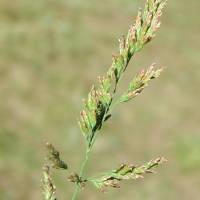|
|
 Spikelets Max Licher @http://swbiodiversity.org, Usage Rights: Creative Commons Attribution-ShareAlike (CC BY-SA) |  Seedhead Max Licher @http://swbiodiversity.org, Usage Rights: Creative Commons Attribution-ShareAlike (CC BY-SA) | | | | |
|
| | |
Origin: Introduced Season: Warm
Habitat Description: Riparian areas, wet meadows, roadsides, cultivated areas, disturbed habitats.
Plant Communities:Riparian, Disturbed Areas
Elevation: 5000 - 8500 feet
Desc:
Introduced perennial, usually with solitary shoots, sometimes loosely tufted; bluish-green, hairless herbage; extensively rhizomatous.
Identification Notes: Seedhead stem is conspicuously flattened, 2-edged. The seedhead is a rather dense, contracted panicle. Creeping rhizomes are present.
Grass Type: Perennial bunchgrass Rhizomes: Y Stolons: N
Large Dense Clump (> 2 feet): N Bushy (highly branched): N
Height with Seedheads: 12 to 24 inches
Seedhead Structure: Branched - contracted Seedhead Droops: N
Flowering Period: Jun - Sep
Number of Flowers per Spikelet: Multi-flowered Spikelets One-sided: N
Awns: Absent Three Awns: N Awns Bent: N
Flower and Seedhead Notes: Seedhead are 3/4 to 4 inches tall, generally 1/6 to 1/3 as wide as long, erect, linear, with 15 to 80 spikelets and mostly with 1 to 3 branches per node.
Blade Hairy:
N
Blade with White Margins:
N
Blade Cross section:
Flat or folded
Blade Notes:
Leaves are mostly along the stem, 3/4 to 4-3/4 inches long, 1/16 to 3/16 inches wide, flat or folded, smooth or minutely rough.
Sheath Hairy:
N
Tuft of Hairs at top of Sheath or Collar:
N
Ligules:
Membranous and hairy
Auricles (Ear-like lobes at collar area:
N
Forage Value:
It is consumed by livestock, deer and elk, but does not produce abundant forage.
|
|